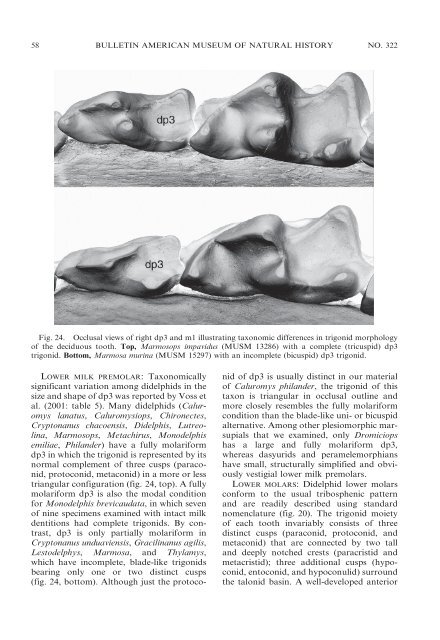phylogenetic relationships and classification of didelphid marsupials ...
phylogenetic relationships and classification of didelphid marsupials ...
phylogenetic relationships and classification of didelphid marsupials ...
Create successful ePaper yourself
Turn your PDF publications into a flip-book with our unique Google optimized e-Paper software.
58 BULLETIN AMERICAN MUSEUM OF NATURAL HISTORY NO. 322<br />
Fig. 24. Occlusal views <strong>of</strong> right dp3 <strong>and</strong> m1 illustrating taxonomic differences in trigonid morphology<br />
<strong>of</strong> the deciduous tooth. Top, Marmosops impavidus (MUSM 13286) with a complete (tricuspid) dp3<br />
trigonid. Bottom, Marmosa murina (MUSM 15297) with an incomplete (bicuspid) dp3 trigonid.<br />
LOWER MILK PREMOLAR: Taxonomically<br />
significant variation among <strong>didelphid</strong>s in the<br />
size <strong>and</strong> shape <strong>of</strong> dp3 was reported by Voss et<br />
al. (2001: table 5). Many <strong>didelphid</strong>s (Caluromys<br />
lanatus, Caluromysiops, Chironectes,<br />
Cryptonanus chacoensis, Didelphis, Lutreolina,<br />
Marmosops, Metachirus, Monodelphis<br />
emiliae, Phil<strong>and</strong>er) have a fully molariform<br />
dp3 in which the trigonid is represented by its<br />
normal complement <strong>of</strong> three cusps (paraconid,<br />
protoconid, metaconid) in a more or less<br />
triangular configuration (fig. 24, top). A fully<br />
molariform dp3 is also the modal condition<br />
for Monodelphis brevicaudata, in which seven<br />
<strong>of</strong> nine specimens examined with intact milk<br />
dentitions had complete trigonids. By contrast,<br />
dp3 is only partially molariform in<br />
Cryptonanus unduaviensis, Gracilinanus agilis,<br />
Lestodelphys, Marmosa, <strong>and</strong> Thylamys,<br />
which have incomplete, blade-like trigonids<br />
bearing only one or two distinct cusps<br />
(fig. 24, bottom). Although just the protoco-<br />
nid <strong>of</strong> dp3 is usually distinct in our material<br />
<strong>of</strong> Caluromys phil<strong>and</strong>er, the trigonid <strong>of</strong> this<br />
taxon is triangular in occlusal outline <strong>and</strong><br />
more closely resembles the fully molariform<br />
condition than the blade-like uni- or bicuspid<br />
alternative. Among other plesiomorphic <strong>marsupials</strong><br />
that we examined, only Dromiciops<br />
has a large <strong>and</strong> fully molariform dp3,<br />
whereas dasyurids <strong>and</strong> peramelemorphians<br />
have small, structurally simplified <strong>and</strong> obviously<br />
vestigial lower milk premolars.<br />
LOWER MOLARS: Didelphid lower molars<br />
conform to the usual tribosphenic pattern<br />
<strong>and</strong> are readily described using st<strong>and</strong>ard<br />
nomenclature (fig. 20). The trigonid moiety<br />
<strong>of</strong> each tooth invariably consists <strong>of</strong> three<br />
distinct cusps (paraconid, protoconid, <strong>and</strong><br />
metaconid) that are connected by two tall<br />
<strong>and</strong> deeply notched crests (paracristid <strong>and</strong><br />
metacristid); three additional cusps (hypoconid,<br />
entoconid, <strong>and</strong> hypoconulid) surround<br />
the talonid basin. A well-developed anterior

















